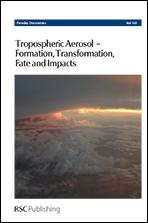The effects of aircraft on climate and pollution. Part II: 20-year impacts of exhaust from all commercial aircraft worldwide treated individually at the subgrid scale
Abstract
This study examines the 20-year impacts of emissions from all commercial aircraft flights worldwide on climate, cloudiness, and atmospheric composition. Aircraft emissions from each individual flight worldwide were modeled to evolve from the subgrid to grid scale with the global model described and evaluated in Part I of this study. Simulations with and without aircraft emissions were run for 20 years. Aircraft emissions were found to be responsible for ∼6% of Arctic surface global warming to date, ∼1.3% of total surface global warming, and ∼4% of global upper tropospheric warming. Arctic warming due to aircraft slightly decreased Arctic sea ice area. Longer simulations should result in more warming due to the further increase in CO2. Aircraft increased atmospheric stability below cruise altitude and decreased it above cruise altitude. The increase in stability decreased cumulus convection in favor of increased stratiform cloudiness. Aircraft increased total cloud fraction on average. Aircraft increased surface and upper tropospheric ozone by ∼0.4% and ∼2.5%, respectively and surface and upper-tropospheric peroxyacetyl nitrate (PAN) by ∼0.1% and ∼5%, respectively. Aircraft emissions increased tropospheric OH, decreasing column CO and CH4 by ∼1.7% and ∼0.9%, respectively. Aircraft emissions increased human mortality worldwide by ∼620 (−240 to 4770) deaths per year, with half due to ozone and the rest to particulate matter less than 2.5 micrometers in diameter (PM2.5).
- This article is part of the themed collection: Tropospheric Aerosol – Formation, Transformation and Impacts

 Please wait while we load your content...
Please wait while we load your content...